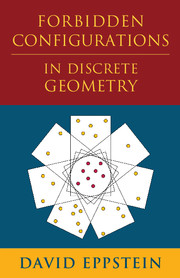Book contents
- Frontmatter
- Contents
- Acknowledgments
- 1 A Happy Ending
- 2 Overview
- 3 Configurations
- 4 Subconfigurations
- 5 Properties, Parameters, and Obstacles
- 6 Computing with Configurations
- 7 Complexity Theory
- 8 Collinearity
- 9 General Position
- 10 General-Position Partitions
- 11 Convexity
- 12 More on Convexity
- 13 Integer Realizations
- 14 The Stretched Geometry of Permutations
- 15 Configurations from Graphs
- 16 Universality
- 17 Stabbing
- 18 The Big Picture
- Bibliography
- Index
16 - Universality
Published online by Cambridge University Press: 04 May 2018
- Frontmatter
- Contents
- Acknowledgments
- 1 A Happy Ending
- 2 Overview
- 3 Configurations
- 4 Subconfigurations
- 5 Properties, Parameters, and Obstacles
- 6 Computing with Configurations
- 7 Complexity Theory
- 8 Collinearity
- 9 General Position
- 10 General-Position Partitions
- 11 Convexity
- 12 More on Convexity
- 13 Integer Realizations
- 14 The Stretched Geometry of Permutations
- 15 Configurations from Graphs
- 16 Universality
- 17 Stabbing
- 18 The Big Picture
- Bibliography
- Index
Summary
A planar graph is a graph that can be drawn in the plane with its vertices as points and its edges as noncrossing curves (often drawn as line segments).Universal point sets are point sets that can form the vertex set of any sufficiently small planar graph. Before defining this concept more carefully as the monotone parameter universal (Definition 16.1), we look at a computer puzzle that has popularized some of these concepts.
Planarity
Planarity is a computer puzzle game based on planar graph drawing, originally devised by John Tantalo and Mary Radcliffe. In it, one is presented with a tangled drawing of a graph (Figure 16.1). The goal is to untangle it, by moving the vertices one by one, until the result has no crossings. As the vertices move, the edges move with them as straight line segments. Each level of the puzzle presents a more complicated graph to be untangled. Although there exist computer algorithms that can solve these puzzles efficiently, their visual complexity nonetheless makes them a challenge to human puzzle-solvers.
The original version of this puzzle generates its graphs from arrangements of randomly generated lines (Figure 16.2, left). However, the sharp angles of these arrangements make it difficult to reconstruct them while solving the puzzle. Indeed, even finding an arrangement that generates a given graph is a hard problem, much harder than finding an untangled drawing for the graph.
Therefore, it can be easier to search for a solution to the puzzle that places the vertices on a grid (or a rough human approximation to a grid), such as the one in Figure 16.2, right. But when we're just starting the puzzle, we don't know what the whole grid drawing will look like, if it even exists. How big should we make the grid squares? If they're too big, the drawing won't fit in the window, and we'll have to waste time and moves shrinking it. But if they're too small, it will be more difficult to precisely place each of the graph vertices into its grid position.
- Type
- Chapter
- Information
- Forbidden Configurations in Discrete Geometry , pp. 177 - 187Publisher: Cambridge University PressPrint publication year: 2018



